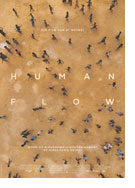

Opening 16 Nov 2017
Directed by:
Ai Weiwei
Writing credits:
Ai Weiwei
Chinese artist Al Weiwei has moved from making art objects out of old Chinese pots plastered with Coke Cola labels to an exhibition room filled with millions of sunflower seeds and now has spent the last year travelling around the world to document the migration of people in the film called Human Flow. He takes us on an overwhelming and excruciating journey across the landscape to take a closer look at the refugee crisis. This one-year global project covers 23 countries using several different camera technics including drones, his mobile phone and wide use of lens and filters. His imagery poetically portrays something beautiful in its coloring but a closer look leaves you with a startlingly raw feeling of despair. Images of people swept up in sand storms to people clinging for their life vests as they head out to sea gives the viewer a helpless sensation that makes us feel either compassion or numbness or even denial. Poignant interviews from leaders of host countries such as Lebanon and Jordan who try to explain their position in this Human Flow and why they believe this is happening and what kind of future is awaiting them as well as us.
Ai himself plays an active role in the film from trying to help people off the boat, to marching from place to place, to telling their stories of what they have lost in their journey in order to gain a bit of respect. He tries to give us a wider view of what is happening which is greater than that of what we would get from the media. He is documenting with these fantastic photographic images of perils of the human race heading towards disaster. Weiwei dares the audience to get close up to these displaced people so that we can understand their plight as well as discovers something much greater. He has decided that it is not just a refugee crisis but a human crisis. It is not a mirror we want to face. Why would these people just pack up and leave to make a journey of uncertainty. They face fences, lose their possessions and loved ones as well as lose their respect in the community. What has become of us? He feels that we have lost our base values and are faced with problems such as overpopulation and lacking of resources. His film has many incredible jewels hidden amidst this vast flow of footage. The film lasts 2 hours and 20 minutes which is unfortunately just too long. While the audience is attempting to absorb all the visual information, they struggle to see the final message. This film has been nominated for several awards which it well deserves, but I would like to see a re-edited version which would emphasis the message. (Shelly Schoeneshoefer)